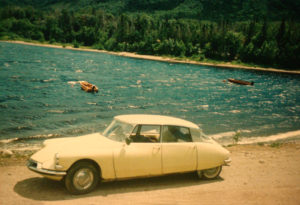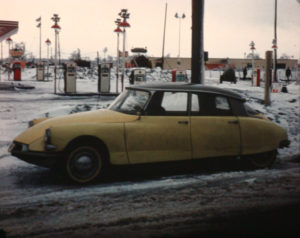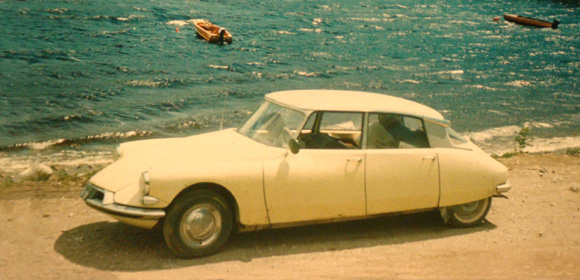by Keith Walker…..
George Dyke who I met at the Ottawa Citroën Club meet asked me to write about my past but not forgotten Citroën. It is about 50 years since I sadly disposed of my beloved Citroën ID 19 due to rust and replaced it with another odd car, a Chevy Corvair station wagon.
My entire article depends upon my memory so it won’t be exact but close. By 1960 my VW beetle was getting a little small for us so looked for a larger car and being from Australia and used to smaller cars so was not impressed with the American monsters around. Also being an engineer I was fascinated by the science in the Citroën so decided I had to have one. They were quite expensive at the time so found a used ID 19 in quite good shape about 2 years old at that time (1960). It was yellow and my wife Joyce hated the colour. The ID is the same as the DS except that it did not have power steering or power brakes and has a normal manual gear change.

I owned the car for about three years and it was my only car so I drove it a lot. I worked at Canadair (now Bombardier) in Montreal at the time and volunteered for a secondment to Boeing in Seattle to work on the Boeing 727 aircraft. I drove the car to Seattle and then later took another secondment with Boeing to Boeing Vertol in Philadelphia to work on the Chinook helicopter. I put a lot of miles on it as well as my normal usage. The Citroën was well known in Montréal by the French Canadian population and was very popular for a short while, but its poor resistance to corrosion from the salt on the road during the winter was not good so its popularity did not last long. The body metal was very thin and they used aluminum in a lot of locations and as you probably know salt just loves aluminum. There were quite a few dealers spread around, much to my surprise, with at least one in each place where I was. Although there were dealers in Montreal, Seattle and Philadelphia the car was not well know by the public except in Montreal so I had some interesting experiences in these places which I will relate.
The car was quite reliable and ran well but the heater was pathetic and the electrical system not good enough to always start the car in the freezing cold Montreal winter, but did start well with the hand cranking handle when really cold. The manual ignition advance and retard control on the instrument panel made the hand cranking safer and easier. I still have the Instruction Book and also had a Repair Manual which unfortunately is now lost. The Instruction Book says that if you had to crank the engine use the extension lever and attach the crank to it. This extension lever and crank did every thing such as tightening the wheel attachment nut, cranking the engine and removing the fenders. Jacking was easy. Let the engine idle with car in raised position, loosen the one wheel nut using the extension lever, put the stand underneath and raise the wheels and remove the wheel with above levers and take spare from front of engine and put on. If rear wheel just use the crank to remove the rear fender. All very marvellous!!!!
At that time the car was just reeking with new ideas such as the hydraulic suspension, front wheel drive and radial ply tires. I took a trip from Seattle into Oregon and while waiting for a light to change, or what ever it was that stopped me, a nice American got out of his car to tell me my tires were flat and the early Michelins did indeed look flat. I explained this to him that was their normal appearance and even got my tire gauge out to check and show him but he did not look very convinced. I parked the car at Crater Lake and the suspension began to subside with its usual wheeze and another nice American did a double take and went over to the car and bent down to look underneath and I hastily went over to tell him not to put his head underneath as it would drop on him and explained about the suspension. Boy there are some strange foreigners in the US.

The Citroën pulled me through some pretty tough episodes thanks to its unique design. On the drive to Seattle in 1961 my wife was 3 months pregnant and as typical she wanted to eat right away when she got up. Well we had stayed the night somewhere (probably in North Dakota) in a little motel and there was not much to eat when she woke up so had to drive at great speed on poor roads to eventually find a greasy spoon. When I left Seattle for Philadelphia via Montreal it was winter and I had some tough winter driving to do but the ability to raise the suspension to clear the snow plus the Michelin tires got me through safely. Joyce was almost due with my son Peter so I then drove on down to Philadelphia to start work and also wait for the birth of Peter. I was to work the weekend and Joyce, not expecting the birth soon, called shortly after I arrived to say she was going to the hospital right away. So in the middle of a snow storm I drove my trusty steed from Philadelphia to Montreal arriving about 2 in the morning. The nurses said I looked the worse for wear. There were no super highways in those days just the old Route 9. Once again the hydraulic suspension, Michelins and front wheel drive pulled me through. I thought the lights were not too good and found, on inspection, that the complete front of the car was covered in ice.
I mentioned earlier that I had a repair manual and did do some repairs my self such as reline the brakes which were, as with every thing about the Citroën, better than other cars, being inboard discs. You also had to be careful about the fluids used in the systems and engine. Somehow the wrong antifreeze got put in the engine and the cylinder head gasket leaked antifreeze into the engine and it seized up. After it cooled down it started and Citroën put a new gasket on and the engine continued on quite well. The motor had wet sleeves but these did not need to be changed over the antifreeze problem.
I was driving along in Montreal one day and there was an explosion at the rear and fluid came out on the road behind me and the ride got rough. Yes one of the rear wheel Hydraulic suspension cylinders burst due to the salt. Believe it or not they had made these cylinders out of aluminum. They had thought of everything except the road salt and had put rubber blocks in the suspension for it to ride on in case of a failure. So I drove home somewhat bumpily but made it with the damaged wheel cylinder.

Sadly the tough usage and salt covered roads took their toll. I thought the car was probably becoming unsafe and heard of a guy who had his doors welded together to support the body. I did not want to go that far so I took it to the wreckers in Montreal.
It’s only recently that today’s cars have the Citroën’s features such as front wheel drive, radial ply tyres and variable rate suspension that André Citroën had like 50 years ago. Can you imagine the hydraulic complication of the semi-automatic gear change of the DS?
It’s a pity I’m getting so old as I would not mind a DS even today. Maybe I should find a friend with one who would let me drive it sometimes.

